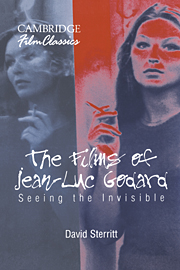3 - My Life to Live
Published online by Cambridge University Press: 12 January 2010
Summary
Would one blush for the religiously realistic art of the cinema if we were not eaten away by an unhappy desire to change the world? But here artistic creation does not mean painting one's soul in things, but painting the soul of things.
–Jean-Luc Godard, 1952.Breathless boosted Godard to the rank of New Wave leader – along with Truffaut, his prizewinning colleague – by introducing him to critics, audiences, and fellow cinéastes as a certified enfant terrible with a taste for the innovative (those jump cuts!) and the offbeat (that ambiguous ending!) rivaled by few others on the contemporary scene.
He quickly started work on The Little Soldier, his second feature. Here he continued his exploration of film-noir terrain, adding a political inflection via its protagonist: an undercover agent combating a left-wing organization during the acutely controversial war for Algerian independence. The drama puzzled many observers with its lack of political coherence, but Godard promptly explained that this was one of its most admirable qualities; his intention, after all, was to depict an ethically confused character in a film meant to seem “like a secret diary, a notebook, or the monologue of someone trying to justify himself before an almost accusing camera, as one does before a lawyer or a psychiatrist.” Godard's own justifications are as problematic as the “thriller” itself – among other things, he suggests that to understand the movie one must somehow “sense” his oftenshifting “distance” from the characters – and it is tempting to write off both the film and the self-analysis as honorable failures in a still-young career.
- Type
- Chapter
- Information
- The Films of Jean-Luc GodardSeeing the Invisible, pp. 61 - 88Publisher: Cambridge University PressPrint publication year: 1999

